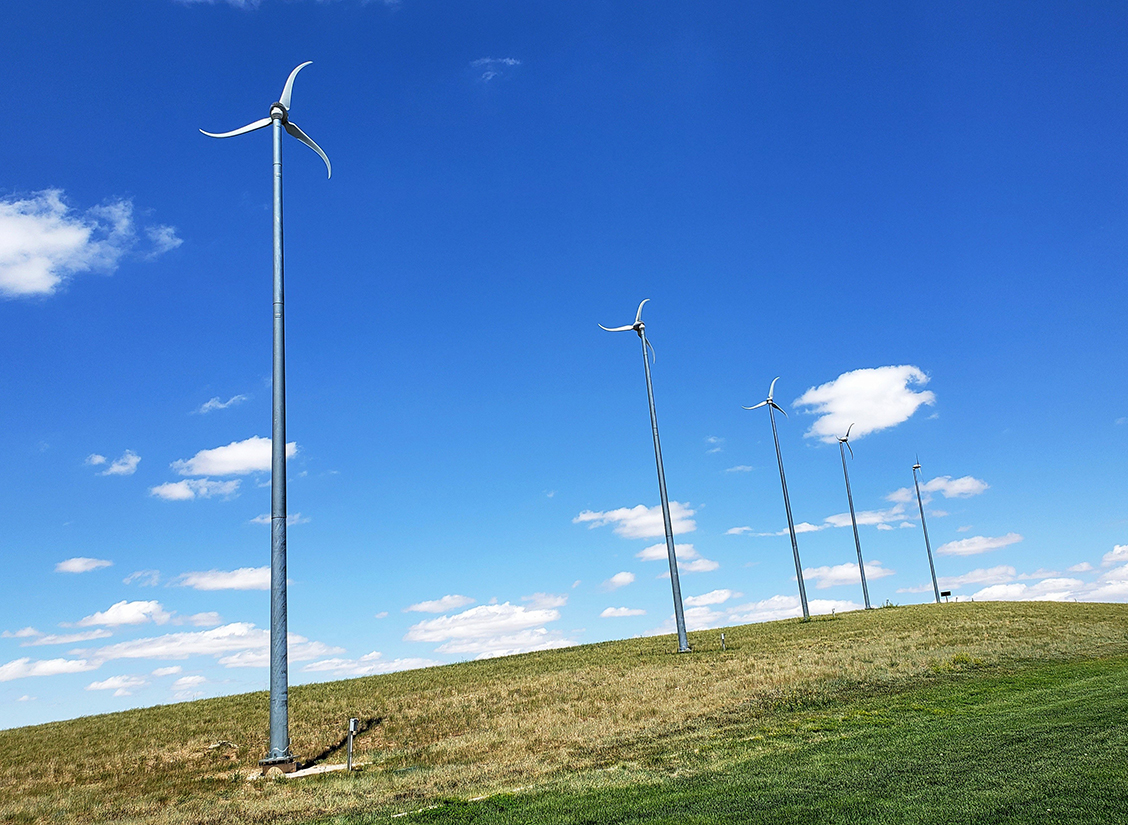Distributed Wind
Distributed Wind
Enabling wind energy for on-site
and local power generation
Enabling wind energy for on-site
and local power generation
Publications News Events Gallery
Capability Overview

Wind turbines used as distributed energy resources—also called distributed wind—produce electricity that is consumed on-site or locally, as opposed to large, centralized wind farms that generate bulk electricity for distant end users.
Distributed wind is a valuable tool in meeting local energy demand. Pacific Northwest National Laboratory’s (PNNL) distributed wind research is funded by the Department of Energy’s Wind Energy Technologies Office (WETO), which advances wind energy technology to contribute maximum societal, economic, and power system benefits. PNNL’s team of distributed wind researchers spans a range of disciplines—Earth system sciences, socio-technical systems, economics, power systems engineering, and geospatial science—to conduct critical, interdisciplinary research that advances wind technologies as distributed energy resources.
Challenges and Solutions
Distributed wind installations can range from a less-than-1-kW off-grid wind turbine at a remote cabin or oil platform, to a 15-kW wind turbine at a home or farm, to several multimegawatt wind turbines at a university campus or manufacturing facility, or connected to the distribution system of a local utility.
With installations in all 50 states, distributed wind energy actively helps individuals, businesses, and communities across the country in:
- Offsetting retail power costs
- Securing long-term power cost certainty
- Supporting grid operations
- Electrifying remote locations and assets not connected to a centralized grid.
Significant opportunity for distributed wind deployment remains untapped, however. To support streamlined adoption of distributed wind energy technologies, PNNL conducts a range of research in market analysis, strategic and technical engagement, wind resource assessments, training, and valuation.
Projects and Programs
PNNL conducts a range of research in market analysis, strategic and technical engagement, wind resource assessments, training, and valuation. Below are overviews of key PNNL distributed wind projects and programs, along with links to additional info.
Rural and Agricultural Income & Savings from Renewable Energy
RAISE is a joint USDA/DOE initiative to help rural small businesses, farmers, and electric cooperatives cut costs and increase income using smaller-scale renewable energy projects and underutilized technologies, such as distributed wind. PNNL leads the lab-based contributions to RAISE, managing and coordinating research, analysis, and outreach.
Distributed Wind Market Report
PNNL has produced the annual Distributed Wind Market Report since 2012. This report provides a comprehensive overview of the distributed wind market and can help guide future investments and decisions by industry, utilities, federal and state agencies, and other interested parties.
Strategize, Engage, Network, Deploy Distributed Wind
Led by PNNL in collaboration with the National Renewable Energy Laboratory, the Strategize, Engage, Network, Deploy Distributed Wind (SEND) project uses strategic and technical stakeholder engagement to address key deployment issues to increase distributed wind deployment.
Tools Assessing Performance
Tools Assessing Performance (TAP) is a multi-laboratory project led by the National Renewable Energy Laboratory and supported by PNNL, Argonne National Laboratory, and Los Alamos National Laboratory. Together, the TAP project team aims to reduce uncertainty in distributed wind production estimates through improved mesoscale wind resource datasets, bias characterization and correction, and obstacle detection and incorporation into flow models.
On-Site Wind for Rural Loads
The On-Site Wind for Rural Load Centers project focuses on evaluating rural energy needs and providing tools and resources for communities considering distributed wind in microgrids, distribution networks, and hybrid systems. Led by Idaho National Laboratory, PNNL leverages valuation frameworks developed under the Microgrid, Infrastructure Resilience, and Advanced Controls Launchpad and RADWIND projects to quantify the value of distributed wind for potential end users.
Energy Technology Innovation Partnership Project
Under the Energy Technology Innovation Partnership Project, PNNL provides technical assistance to remote, island, and islanded communities to improve the affordability and reliability of their energy systems. PNNL’s distributed wind research team contributes resource assessments for these communities.
FEMP Distributed Energy and Energy Procurement Program
PNNL supports federal wind energy procurement through the Distributed Energy and Energy Procurement Program. Federal Energy Management Program (FEMP) technical resources are catered to United States federal agencies with a number of on-demand, web-based trainings that are available to anyone interested in learning about the fundamentals of distributed wind.
Stay in the Know
Complete and submit the form below to subscribe to our Distributed Wind mailing list: